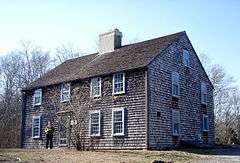John and Priscilla Alden Family Sites
|
John and Priscilla Alden Family Sites | |
|
John Alden House, 2009 | |
  | |
| Location | 105 Alden St., Duxbury, Massachusetts |
|---|---|
| Coordinates | 42°2′42″N 70°41′9″W / 42.04500°N 70.68583°WCoordinates: 42°2′42″N 70°41′9″W / 42.04500°N 70.68583°W |
| Area | 2.4 acres (0.97 ha) |
| Built | c. 1630 |
| NRHP Reference # | [1] |
| Significant dates | |
| Added to NRHP | December 14, 1978 |
| Designated NHL | October 6, 2008[2] |
The John and Priscilla Alden Family Sites is a National Historic Landmark consisting of two separate properties in Duxbury, Massachusetts, United States. Both properties are significant for their association with John Alden, one of the settlers of the Plymouth Colony who came to North America on board the Mayflower, and held numerous posts of importance in the colony. Alden and his relationship with Priscilla Mullins were memorialized by Henry Wadsworth Longfellow in The Courtship of Miles Standish, a narrative poem that made the story a piece of American folklore.
One of the two properties contains the archaeological remains of the house John Alden built c. 1630, and is also significant in the field of historical archaeology as the mature field work of Roland Wells Robbins (1908-1987), an early historical archaeologist. It is on land owned by the Town of Duxbury. On the second property stands a house which was traditionally dated to c. 1657 as a work by Alden, but is, by forensic analysis, judged to have been built around 1700, probably by John Alden's grandson. This property has been under the continuous ownership of the Alden family; it is now managed by a family foundation as a historic house museum.[3]
Alden Homestead Site
The Alden Homestead Site is located on a knoll overlooking the Bluefish River, on a parcel of land that is now owned by the Town of Duxbury, and is principally occupied by the Duxbury Junior High School. The site is marked by wooden posts which outline the site of the foundation excavated by Roland Wells Robbins in 1960. A bronze marker is mounted on a granite stone above 75 feet (23 m) from the site, bearing the inscription "Site of the John Alden House built 1627". The property is part of a 100-acre (40 ha) parcel granted to John Alden in 1621, and is about 750 feet (230 m) from the John Alden House, which abuts the town property.[3]
The site has been of archaeological interest since the 19th century, when historical artifacts were found in the area. The first formal archaeological survey of the area was conducted in the 1950s, but did not locate the homestead foundation. The Alden Kindred Foundation, owners of the John Alden House, hired Robbins in 1960 to investigate the area. He located and excavated a granite foundation, 38 by 10.5 feet (11.6 m × 3.2 m) in size, with evidence of a deep cellar hole underneath the western end. He excavated the area within the foundation, including the cellar, and recovered more than 7,000 historical artifacts and 2,000 prehistoric Native American artifacts. Most of these were nails and other construction materials. A significant number of cultural artifacts provide evidence that the site was last occupied in the 1650s. In consultation with other archaeologists who analyzed the finds, and based on documentary evidence, Robbins assigned the house a construction date of 1632.[3]
Later research, including new fieldwork and reinterpretation of Robbins' work by Craig Chartier, suggests that the foundation might be an addition to an older 20 by 20 feet (6.1 m × 6.1 m) structure which was earthfast (i.e. built on wooden posts set in the ground), a building method known from other Plymouth Colony sites. Chartier concludes that this site was Alden's home for most of his time in Plymouth.[3]
John Alden House

The John Alden House is a historic house museum that was purportedly home to John and Priscilla Alden. It is located at 105 Alden Street in Duxbury, Massachusetts. Scholarship variously dates it as built in 1653 according to family tradition, or c. 1700 according to more recent dendrochronology testing of the beams.[3]
Alden was ship's cooper on the Mayflower who arrived in Plymouth in 1620 and later moved to Duxbury. Although not a Pilgrim himself, he was an important figure throughout the period of the Plymouth Colony. This house may have used materials from Alden's earlier house which was nearby.
Recognition
The sites were listed on the National Register of Historic Places in 1978,[1] and were declared a National Historic Landmark on October 6, 2008.[2]
See also
- List of the oldest buildings in Massachusetts
- List of National Historic Landmarks in Massachusetts
- National Register of Historic Places listings in Plymouth County, Massachusetts
References
- 1 2 National Park Service (2009-03-13). "National Register Information System". National Register of Historic Places. National Park Service.
- 1 2 "NHL summary description of John and Priscilla Alden Family Sites". National Park Service. Retrieved 2014-11-20.
- 1 2 3 4 5 Tom McCarthy; Erika K Martin Seibert; Patty Henry; Edward L. Bell; Betsy Friedberg; Phil Bergen (March 2007). "National Historic Landmark Nomination: John and Priscilla Alden Family Sites / Alden House (DUX.38) and Original Alden Homestead Site (aka Alden I Site, DUX-HA-3)" (pdf). National Park Service. Retrieved 2014-11-20.
Further reading
- Levine, Sassaman, and Nassaney, eds. The Archaeological Northeast (Chapter: "An Interdisciplinary Study of the John Alden Houses, 1627 and 1653, Duxbury, Massachusetts: Archaeology and Architecture" by Mitchell T. Mulholland). Westport, CT: Bergin & Garvey (1999).

